Career Development Plan Report: Gibb's Model, Skills, and Interview
VerifiedAdded on 2022/12/30
|11
|2529
|97
Report
AI Summary
This report details a student's career development plan, beginning with an introduction to career development strategies and the significance of setting both short-term and long-term goals. The main body of the report centers on Gibb's Reflective Model, providing a step-by-step analysis of a past group project experience. The analysis includes a description of the event, the feelings experienced, an evaluation of the outcomes, a thorough analysis of contributing factors, and a conclusion with an actionable plan for future scenarios. The report also includes a professional career development plan with skills assessment, highlighting areas for improvement in presentation, problem-solving, and organizing skills. Finally, the report includes a job interview section, answering common questions and providing insights into the candidate's aspirations and abilities. The report concludes by reiterating the value of the Gibb's Reflective Model and a well-structured career development plan for enhancing skills and achieving professional goals.
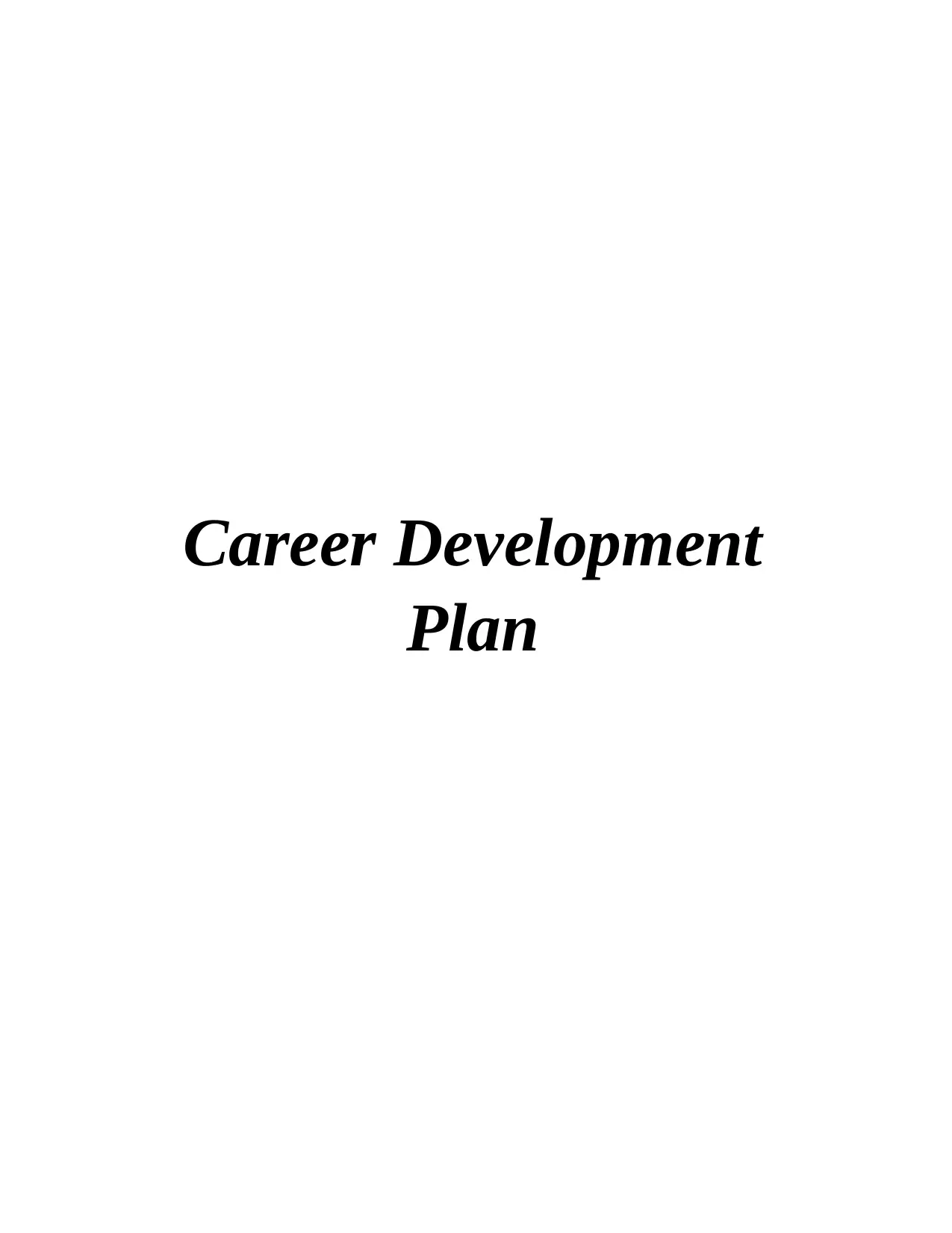
Career Development
Plan
Plan
Paraphrase This Document
Need a fresh take? Get an instant paraphrase of this document with our AI Paraphraser
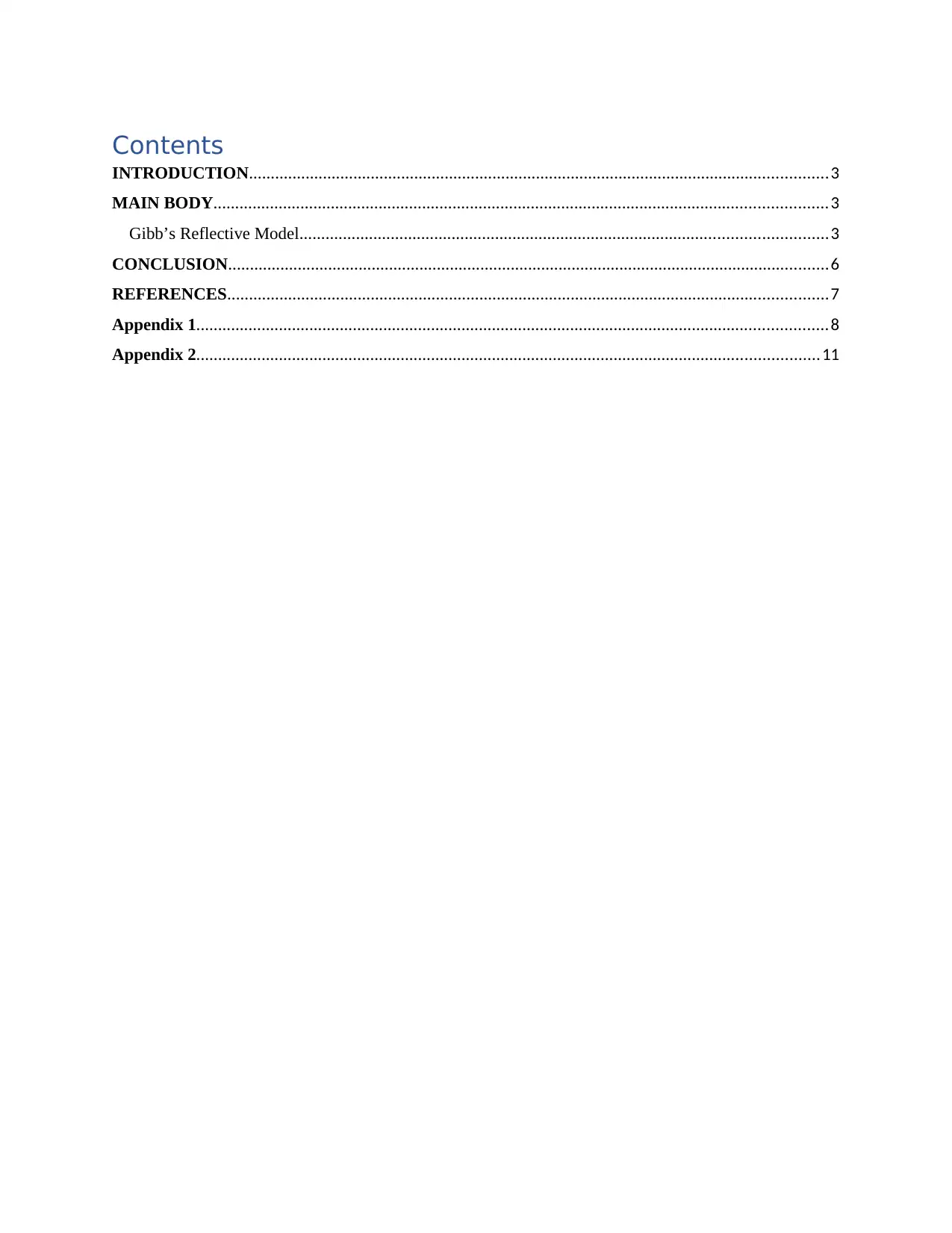
Contents
INTRODUCTION.....................................................................................................................................3
MAIN BODY.............................................................................................................................................3
Gibb’s Reflective Model.........................................................................................................................3
CONCLUSION..........................................................................................................................................6
REFERENCES..........................................................................................................................................7
Appendix 1.................................................................................................................................................8
Appendix 2...............................................................................................................................................11
INTRODUCTION.....................................................................................................................................3
MAIN BODY.............................................................................................................................................3
Gibb’s Reflective Model.........................................................................................................................3
CONCLUSION..........................................................................................................................................6
REFERENCES..........................................................................................................................................7
Appendix 1.................................................................................................................................................8
Appendix 2...............................................................................................................................................11
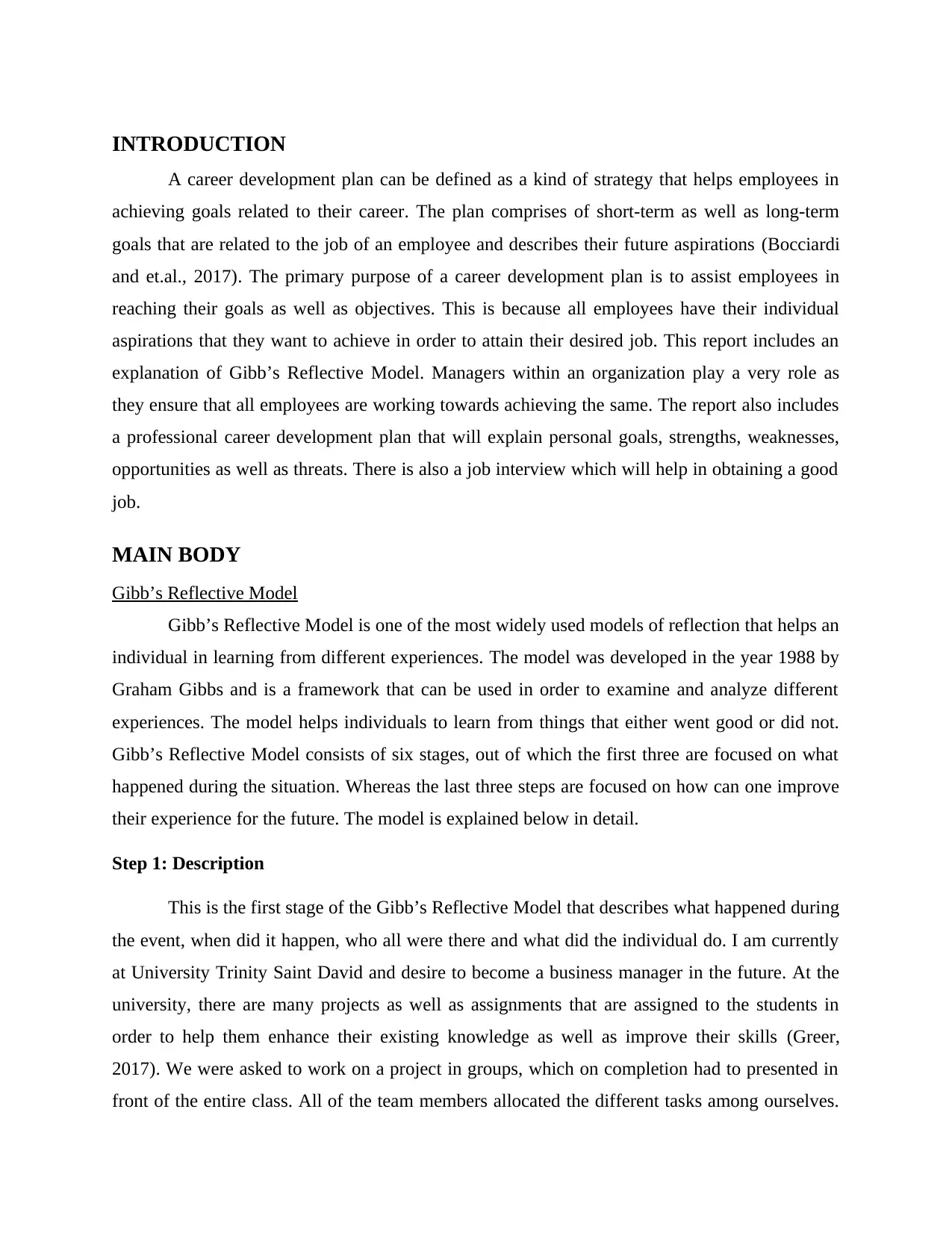
INTRODUCTION
A career development plan can be defined as a kind of strategy that helps employees in
achieving goals related to their career. The plan comprises of short-term as well as long-term
goals that are related to the job of an employee and describes their future aspirations (Bocciardi
and et.al., 2017). The primary purpose of a career development plan is to assist employees in
reaching their goals as well as objectives. This is because all employees have their individual
aspirations that they want to achieve in order to attain their desired job. This report includes an
explanation of Gibb’s Reflective Model. Managers within an organization play a very role as
they ensure that all employees are working towards achieving the same. The report also includes
a professional career development plan that will explain personal goals, strengths, weaknesses,
opportunities as well as threats. There is also a job interview which will help in obtaining a good
job.
MAIN BODY
Gibb’s Reflective Model
Gibb’s Reflective Model is one of the most widely used models of reflection that helps an
individual in learning from different experiences. The model was developed in the year 1988 by
Graham Gibbs and is a framework that can be used in order to examine and analyze different
experiences. The model helps individuals to learn from things that either went good or did not.
Gibb’s Reflective Model consists of six stages, out of which the first three are focused on what
happened during the situation. Whereas the last three steps are focused on how can one improve
their experience for the future. The model is explained below in detail.
Step 1: Description
This is the first stage of the Gibb’s Reflective Model that describes what happened during
the event, when did it happen, who all were there and what did the individual do. I am currently
at University Trinity Saint David and desire to become a business manager in the future. At the
university, there are many projects as well as assignments that are assigned to the students in
order to help them enhance their existing knowledge as well as improve their skills (Greer,
2017). We were asked to work on a project in groups, which on completion had to presented in
front of the entire class. All of the team members allocated the different tasks among ourselves.
A career development plan can be defined as a kind of strategy that helps employees in
achieving goals related to their career. The plan comprises of short-term as well as long-term
goals that are related to the job of an employee and describes their future aspirations (Bocciardi
and et.al., 2017). The primary purpose of a career development plan is to assist employees in
reaching their goals as well as objectives. This is because all employees have their individual
aspirations that they want to achieve in order to attain their desired job. This report includes an
explanation of Gibb’s Reflective Model. Managers within an organization play a very role as
they ensure that all employees are working towards achieving the same. The report also includes
a professional career development plan that will explain personal goals, strengths, weaknesses,
opportunities as well as threats. There is also a job interview which will help in obtaining a good
job.
MAIN BODY
Gibb’s Reflective Model
Gibb’s Reflective Model is one of the most widely used models of reflection that helps an
individual in learning from different experiences. The model was developed in the year 1988 by
Graham Gibbs and is a framework that can be used in order to examine and analyze different
experiences. The model helps individuals to learn from things that either went good or did not.
Gibb’s Reflective Model consists of six stages, out of which the first three are focused on what
happened during the situation. Whereas the last three steps are focused on how can one improve
their experience for the future. The model is explained below in detail.
Step 1: Description
This is the first stage of the Gibb’s Reflective Model that describes what happened during
the event, when did it happen, who all were there and what did the individual do. I am currently
at University Trinity Saint David and desire to become a business manager in the future. At the
university, there are many projects as well as assignments that are assigned to the students in
order to help them enhance their existing knowledge as well as improve their skills (Greer,
2017). We were asked to work on a project in groups, which on completion had to presented in
front of the entire class. All of the team members allocated the different tasks among ourselves.
⊘ This is a preview!⊘
Do you want full access?
Subscribe today to unlock all pages.

Trusted by 1+ million students worldwide
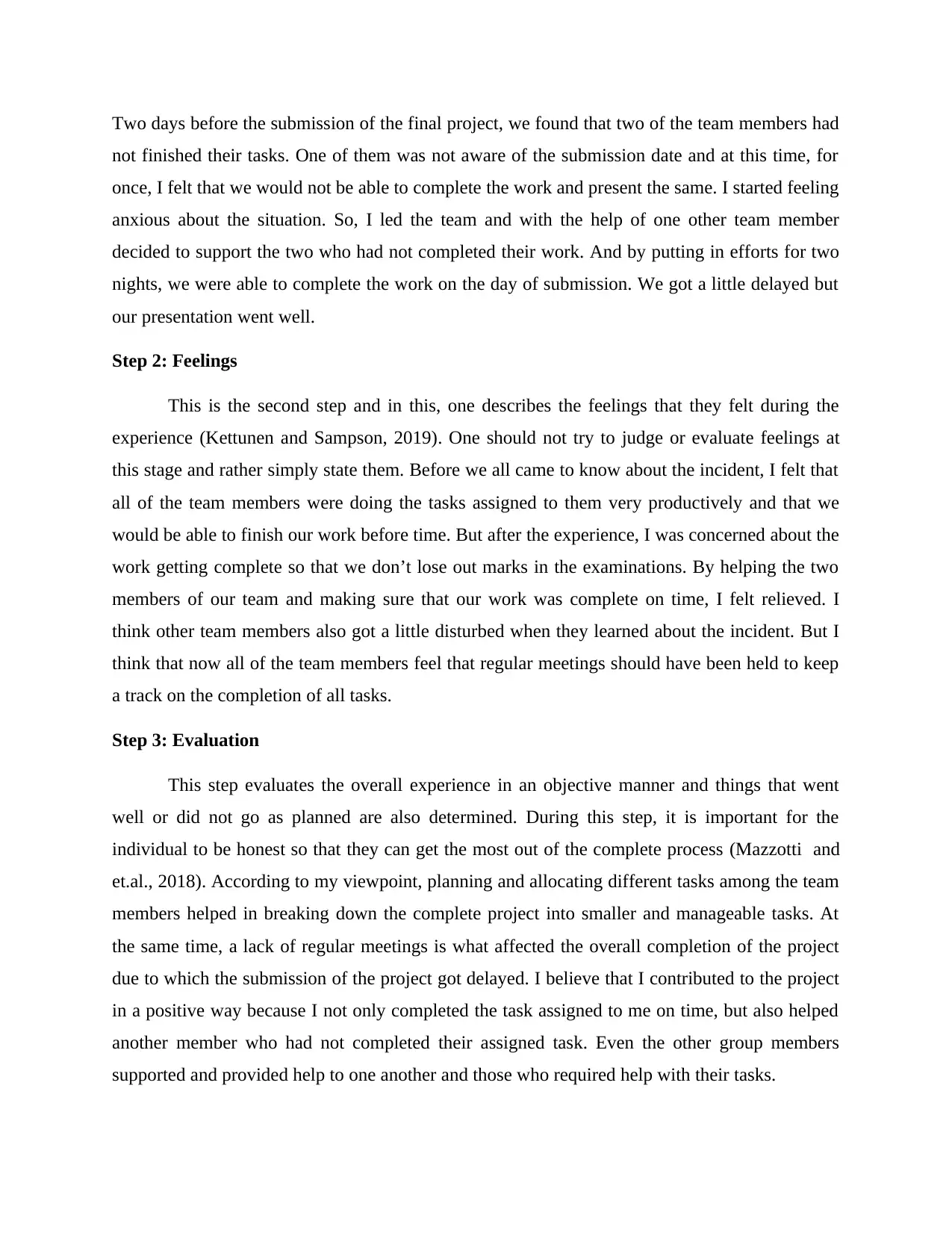
Two days before the submission of the final project, we found that two of the team members had
not finished their tasks. One of them was not aware of the submission date and at this time, for
once, I felt that we would not be able to complete the work and present the same. I started feeling
anxious about the situation. So, I led the team and with the help of one other team member
decided to support the two who had not completed their work. And by putting in efforts for two
nights, we were able to complete the work on the day of submission. We got a little delayed but
our presentation went well.
Step 2: Feelings
This is the second step and in this, one describes the feelings that they felt during the
experience (Kettunen and Sampson, 2019). One should not try to judge or evaluate feelings at
this stage and rather simply state them. Before we all came to know about the incident, I felt that
all of the team members were doing the tasks assigned to them very productively and that we
would be able to finish our work before time. But after the experience, I was concerned about the
work getting complete so that we don’t lose out marks in the examinations. By helping the two
members of our team and making sure that our work was complete on time, I felt relieved. I
think other team members also got a little disturbed when they learned about the incident. But I
think that now all of the team members feel that regular meetings should have been held to keep
a track on the completion of all tasks.
Step 3: Evaluation
This step evaluates the overall experience in an objective manner and things that went
well or did not go as planned are also determined. During this step, it is important for the
individual to be honest so that they can get the most out of the complete process (Mazzotti and
et.al., 2018). According to my viewpoint, planning and allocating different tasks among the team
members helped in breaking down the complete project into smaller and manageable tasks. At
the same time, a lack of regular meetings is what affected the overall completion of the project
due to which the submission of the project got delayed. I believe that I contributed to the project
in a positive way because I not only completed the task assigned to me on time, but also helped
another member who had not completed their assigned task. Even the other group members
supported and provided help to one another and those who required help with their tasks.
not finished their tasks. One of them was not aware of the submission date and at this time, for
once, I felt that we would not be able to complete the work and present the same. I started feeling
anxious about the situation. So, I led the team and with the help of one other team member
decided to support the two who had not completed their work. And by putting in efforts for two
nights, we were able to complete the work on the day of submission. We got a little delayed but
our presentation went well.
Step 2: Feelings
This is the second step and in this, one describes the feelings that they felt during the
experience (Kettunen and Sampson, 2019). One should not try to judge or evaluate feelings at
this stage and rather simply state them. Before we all came to know about the incident, I felt that
all of the team members were doing the tasks assigned to them very productively and that we
would be able to finish our work before time. But after the experience, I was concerned about the
work getting complete so that we don’t lose out marks in the examinations. By helping the two
members of our team and making sure that our work was complete on time, I felt relieved. I
think other team members also got a little disturbed when they learned about the incident. But I
think that now all of the team members feel that regular meetings should have been held to keep
a track on the completion of all tasks.
Step 3: Evaluation
This step evaluates the overall experience in an objective manner and things that went
well or did not go as planned are also determined. During this step, it is important for the
individual to be honest so that they can get the most out of the complete process (Mazzotti and
et.al., 2018). According to my viewpoint, planning and allocating different tasks among the team
members helped in breaking down the complete project into smaller and manageable tasks. At
the same time, a lack of regular meetings is what affected the overall completion of the project
due to which the submission of the project got delayed. I believe that I contributed to the project
in a positive way because I not only completed the task assigned to me on time, but also helped
another member who had not completed their assigned task. Even the other group members
supported and provided help to one another and those who required help with their tasks.
Paraphrase This Document
Need a fresh take? Get an instant paraphrase of this document with our AI Paraphraser
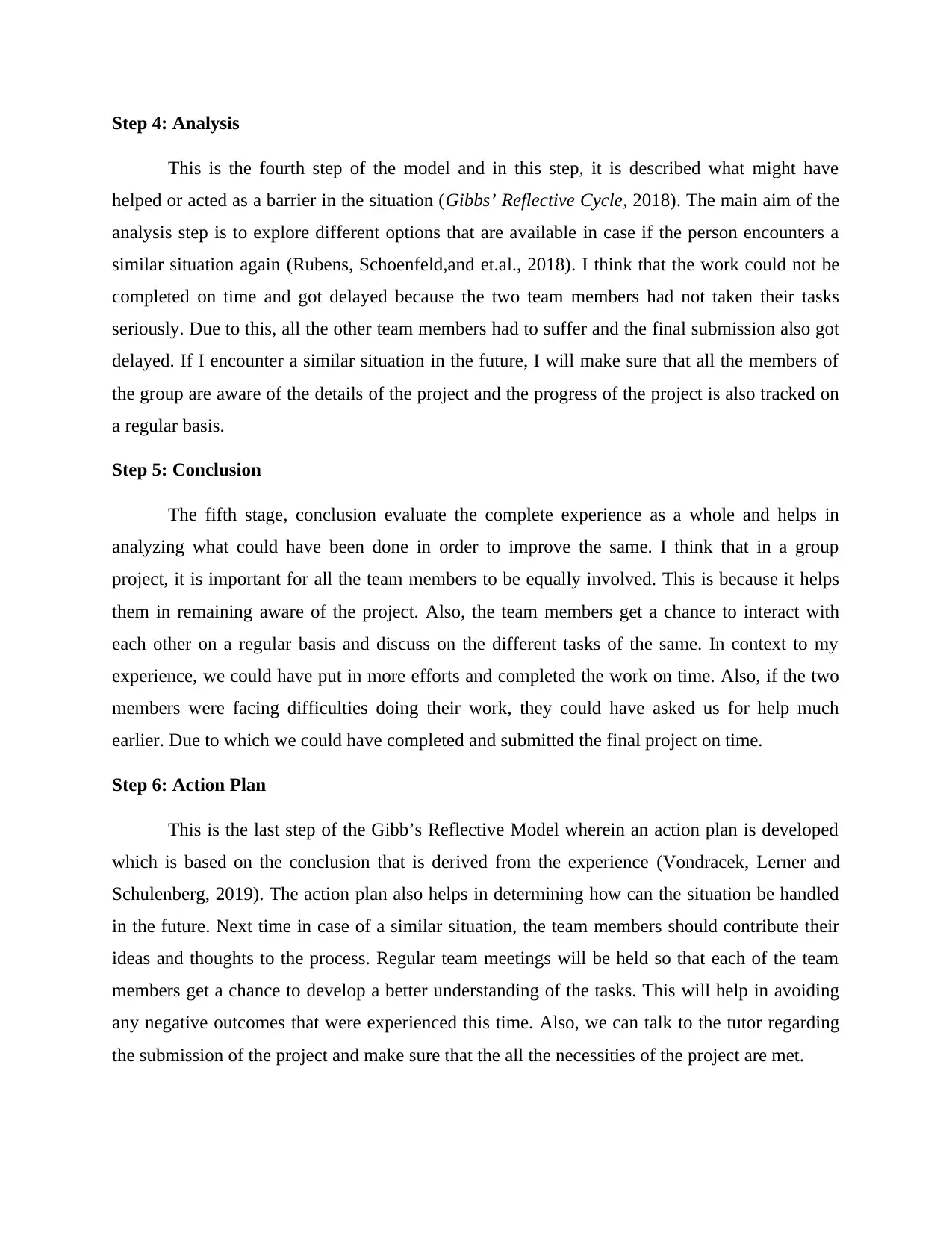
Step 4: Analysis
This is the fourth step of the model and in this step, it is described what might have
helped or acted as a barrier in the situation (Gibbs’ Reflective Cycle, 2018). The main aim of the
analysis step is to explore different options that are available in case if the person encounters a
similar situation again (Rubens, Schoenfeld,and et.al., 2018). I think that the work could not be
completed on time and got delayed because the two team members had not taken their tasks
seriously. Due to this, all the other team members had to suffer and the final submission also got
delayed. If I encounter a similar situation in the future, I will make sure that all the members of
the group are aware of the details of the project and the progress of the project is also tracked on
a regular basis.
Step 5: Conclusion
The fifth stage, conclusion evaluate the complete experience as a whole and helps in
analyzing what could have been done in order to improve the same. I think that in a group
project, it is important for all the team members to be equally involved. This is because it helps
them in remaining aware of the project. Also, the team members get a chance to interact with
each other on a regular basis and discuss on the different tasks of the same. In context to my
experience, we could have put in more efforts and completed the work on time. Also, if the two
members were facing difficulties doing their work, they could have asked us for help much
earlier. Due to which we could have completed and submitted the final project on time.
Step 6: Action Plan
This is the last step of the Gibb’s Reflective Model wherein an action plan is developed
which is based on the conclusion that is derived from the experience (Vondracek, Lerner and
Schulenberg, 2019). The action plan also helps in determining how can the situation be handled
in the future. Next time in case of a similar situation, the team members should contribute their
ideas and thoughts to the process. Regular team meetings will be held so that each of the team
members get a chance to develop a better understanding of the tasks. This will help in avoiding
any negative outcomes that were experienced this time. Also, we can talk to the tutor regarding
the submission of the project and make sure that the all the necessities of the project are met.
This is the fourth step of the model and in this step, it is described what might have
helped or acted as a barrier in the situation (Gibbs’ Reflective Cycle, 2018). The main aim of the
analysis step is to explore different options that are available in case if the person encounters a
similar situation again (Rubens, Schoenfeld,and et.al., 2018). I think that the work could not be
completed on time and got delayed because the two team members had not taken their tasks
seriously. Due to this, all the other team members had to suffer and the final submission also got
delayed. If I encounter a similar situation in the future, I will make sure that all the members of
the group are aware of the details of the project and the progress of the project is also tracked on
a regular basis.
Step 5: Conclusion
The fifth stage, conclusion evaluate the complete experience as a whole and helps in
analyzing what could have been done in order to improve the same. I think that in a group
project, it is important for all the team members to be equally involved. This is because it helps
them in remaining aware of the project. Also, the team members get a chance to interact with
each other on a regular basis and discuss on the different tasks of the same. In context to my
experience, we could have put in more efforts and completed the work on time. Also, if the two
members were facing difficulties doing their work, they could have asked us for help much
earlier. Due to which we could have completed and submitted the final project on time.
Step 6: Action Plan
This is the last step of the Gibb’s Reflective Model wherein an action plan is developed
which is based on the conclusion that is derived from the experience (Vondracek, Lerner and
Schulenberg, 2019). The action plan also helps in determining how can the situation be handled
in the future. Next time in case of a similar situation, the team members should contribute their
ideas and thoughts to the process. Regular team meetings will be held so that each of the team
members get a chance to develop a better understanding of the tasks. This will help in avoiding
any negative outcomes that were experienced this time. Also, we can talk to the tutor regarding
the submission of the project and make sure that the all the necessities of the project are met.
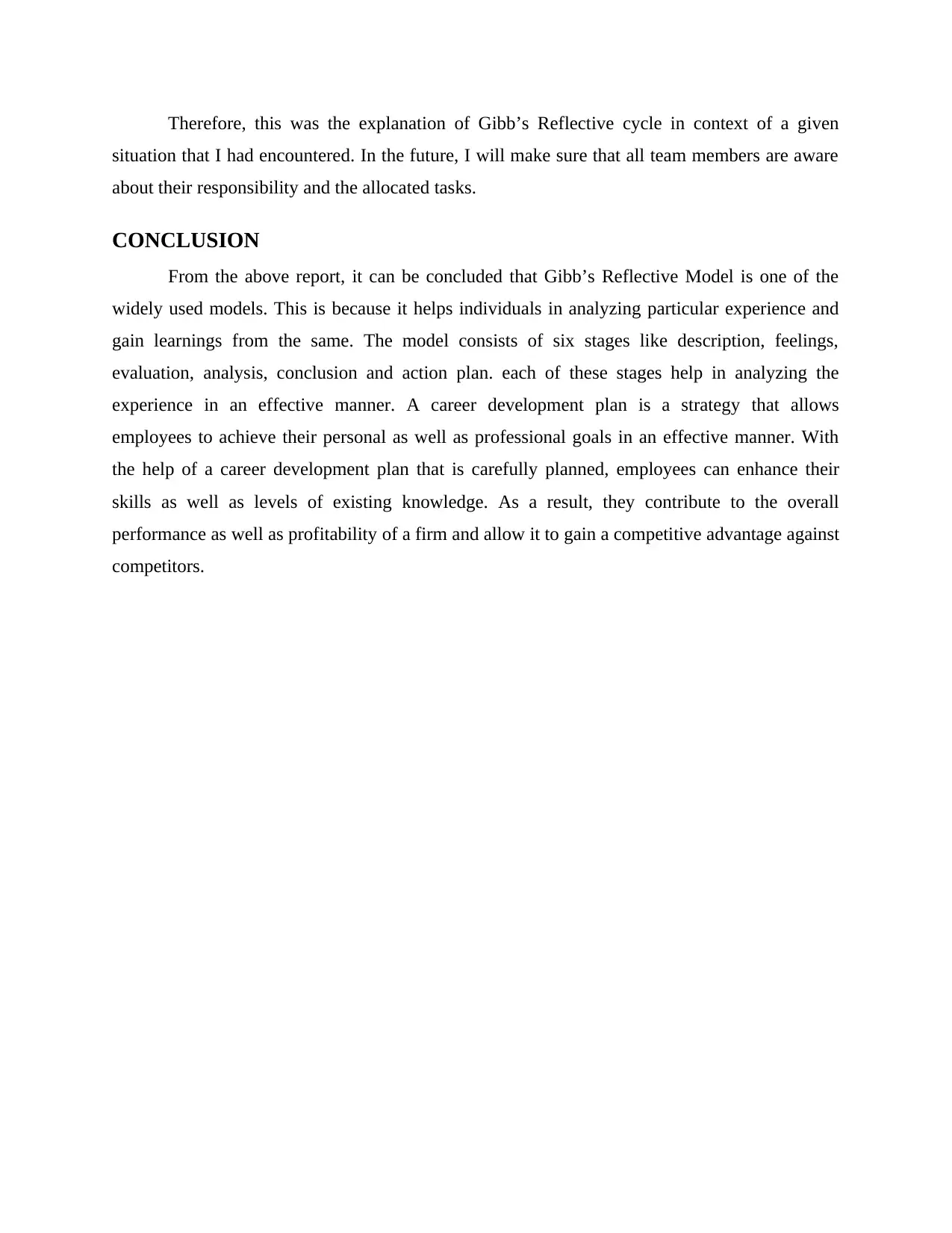
Therefore, this was the explanation of Gibb’s Reflective cycle in context of a given
situation that I had encountered. In the future, I will make sure that all team members are aware
about their responsibility and the allocated tasks.
CONCLUSION
From the above report, it can be concluded that Gibb’s Reflective Model is one of the
widely used models. This is because it helps individuals in analyzing particular experience and
gain learnings from the same. The model consists of six stages like description, feelings,
evaluation, analysis, conclusion and action plan. each of these stages help in analyzing the
experience in an effective manner. A career development plan is a strategy that allows
employees to achieve their personal as well as professional goals in an effective manner. With
the help of a career development plan that is carefully planned, employees can enhance their
skills as well as levels of existing knowledge. As a result, they contribute to the overall
performance as well as profitability of a firm and allow it to gain a competitive advantage against
competitors.
situation that I had encountered. In the future, I will make sure that all team members are aware
about their responsibility and the allocated tasks.
CONCLUSION
From the above report, it can be concluded that Gibb’s Reflective Model is one of the
widely used models. This is because it helps individuals in analyzing particular experience and
gain learnings from the same. The model consists of six stages like description, feelings,
evaluation, analysis, conclusion and action plan. each of these stages help in analyzing the
experience in an effective manner. A career development plan is a strategy that allows
employees to achieve their personal as well as professional goals in an effective manner. With
the help of a career development plan that is carefully planned, employees can enhance their
skills as well as levels of existing knowledge. As a result, they contribute to the overall
performance as well as profitability of a firm and allow it to gain a competitive advantage against
competitors.
⊘ This is a preview!⊘
Do you want full access?
Subscribe today to unlock all pages.

Trusted by 1+ million students worldwide
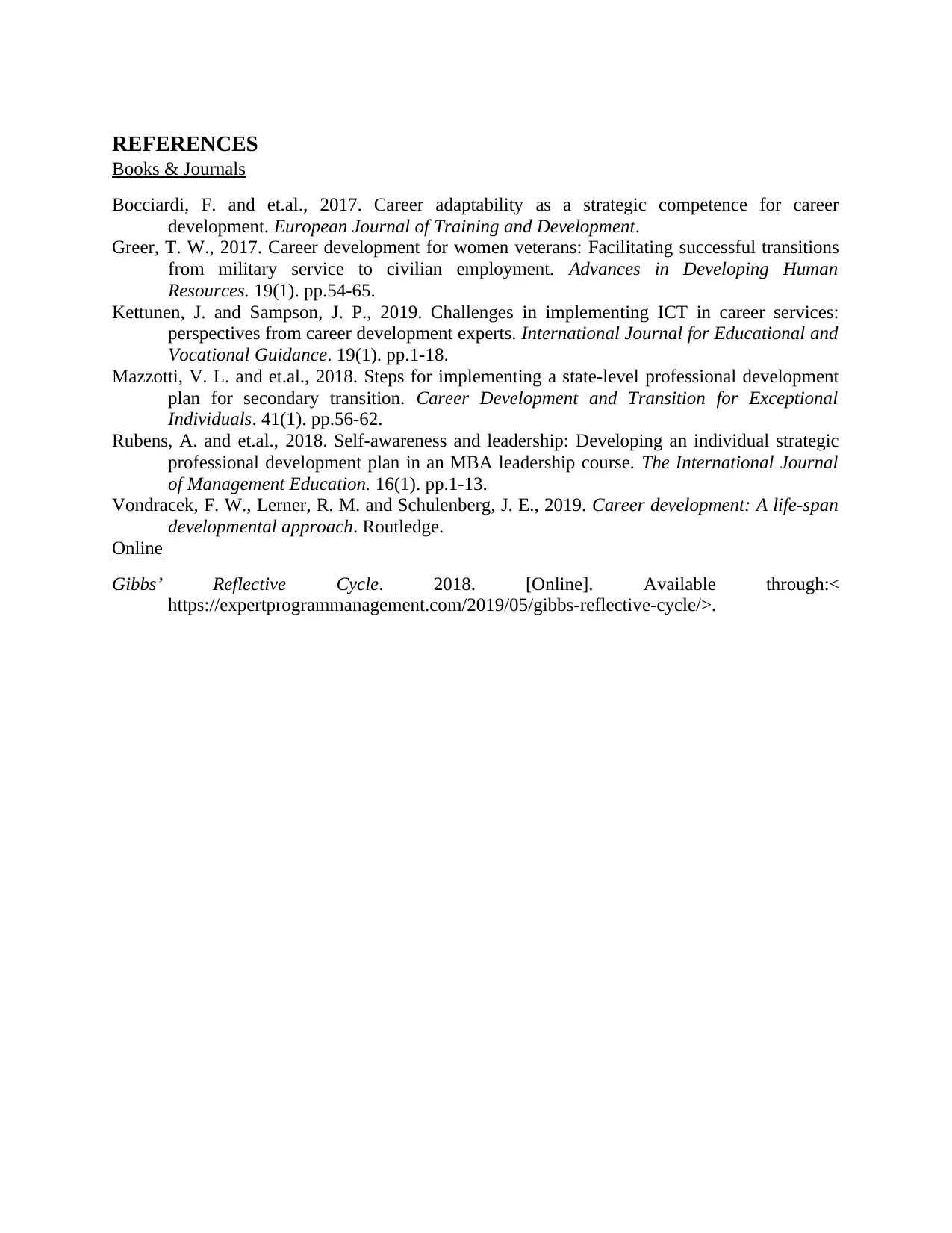
REFERENCES
Books & Journals
Bocciardi, F. and et.al., 2017. Career adaptability as a strategic competence for career
development. European Journal of Training and Development.
Greer, T. W., 2017. Career development for women veterans: Facilitating successful transitions
from military service to civilian employment. Advances in Developing Human
Resources. 19(1). pp.54-65.
Kettunen, J. and Sampson, J. P., 2019. Challenges in implementing ICT in career services:
perspectives from career development experts. International Journal for Educational and
Vocational Guidance. 19(1). pp.1-18.
Mazzotti, V. L. and et.al., 2018. Steps for implementing a state-level professional development
plan for secondary transition. Career Development and Transition for Exceptional
Individuals. 41(1). pp.56-62.
Rubens, A. and et.al., 2018. Self-awareness and leadership: Developing an individual strategic
professional development plan in an MBA leadership course. The International Journal
of Management Education. 16(1). pp.1-13.
Vondracek, F. W., Lerner, R. M. and Schulenberg, J. E., 2019. Career development: A life-span
developmental approach. Routledge.
Online
Gibbs’ Reflective Cycle. 2018. [Online]. Available through:<
https://expertprogrammanagement.com/2019/05/gibbs-reflective-cycle/>.
Books & Journals
Bocciardi, F. and et.al., 2017. Career adaptability as a strategic competence for career
development. European Journal of Training and Development.
Greer, T. W., 2017. Career development for women veterans: Facilitating successful transitions
from military service to civilian employment. Advances in Developing Human
Resources. 19(1). pp.54-65.
Kettunen, J. and Sampson, J. P., 2019. Challenges in implementing ICT in career services:
perspectives from career development experts. International Journal for Educational and
Vocational Guidance. 19(1). pp.1-18.
Mazzotti, V. L. and et.al., 2018. Steps for implementing a state-level professional development
plan for secondary transition. Career Development and Transition for Exceptional
Individuals. 41(1). pp.56-62.
Rubens, A. and et.al., 2018. Self-awareness and leadership: Developing an individual strategic
professional development plan in an MBA leadership course. The International Journal
of Management Education. 16(1). pp.1-13.
Vondracek, F. W., Lerner, R. M. and Schulenberg, J. E., 2019. Career development: A life-span
developmental approach. Routledge.
Online
Gibbs’ Reflective Cycle. 2018. [Online]. Available through:<
https://expertprogrammanagement.com/2019/05/gibbs-reflective-cycle/>.
Paraphrase This Document
Need a fresh take? Get an instant paraphrase of this document with our AI Paraphraser
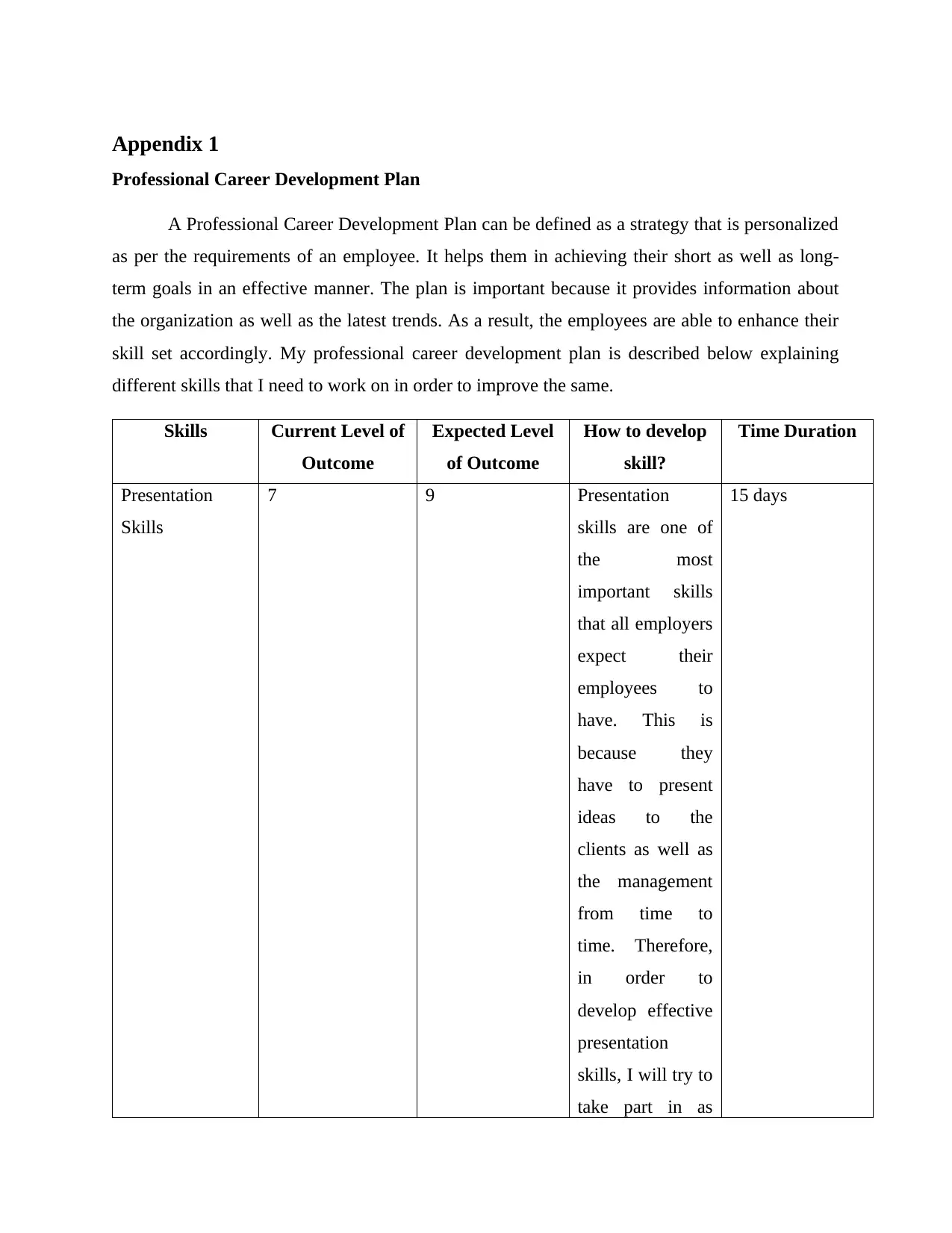
Appendix 1
Professional Career Development Plan
A Professional Career Development Plan can be defined as a strategy that is personalized
as per the requirements of an employee. It helps them in achieving their short as well as long-
term goals in an effective manner. The plan is important because it provides information about
the organization as well as the latest trends. As a result, the employees are able to enhance their
skill set accordingly. My professional career development plan is described below explaining
different skills that I need to work on in order to improve the same.
Skills Current Level of
Outcome
Expected Level
of Outcome
How to develop
skill?
Time Duration
Presentation
Skills
7 9 Presentation
skills are one of
the most
important skills
that all employers
expect their
employees to
have. This is
because they
have to present
ideas to the
clients as well as
the management
from time to
time. Therefore,
in order to
develop effective
presentation
skills, I will try to
take part in as
15 days
Professional Career Development Plan
A Professional Career Development Plan can be defined as a strategy that is personalized
as per the requirements of an employee. It helps them in achieving their short as well as long-
term goals in an effective manner. The plan is important because it provides information about
the organization as well as the latest trends. As a result, the employees are able to enhance their
skill set accordingly. My professional career development plan is described below explaining
different skills that I need to work on in order to improve the same.
Skills Current Level of
Outcome
Expected Level
of Outcome
How to develop
skill?
Time Duration
Presentation
Skills
7 9 Presentation
skills are one of
the most
important skills
that all employers
expect their
employees to
have. This is
because they
have to present
ideas to the
clients as well as
the management
from time to
time. Therefore,
in order to
develop effective
presentation
skills, I will try to
take part in as
15 days
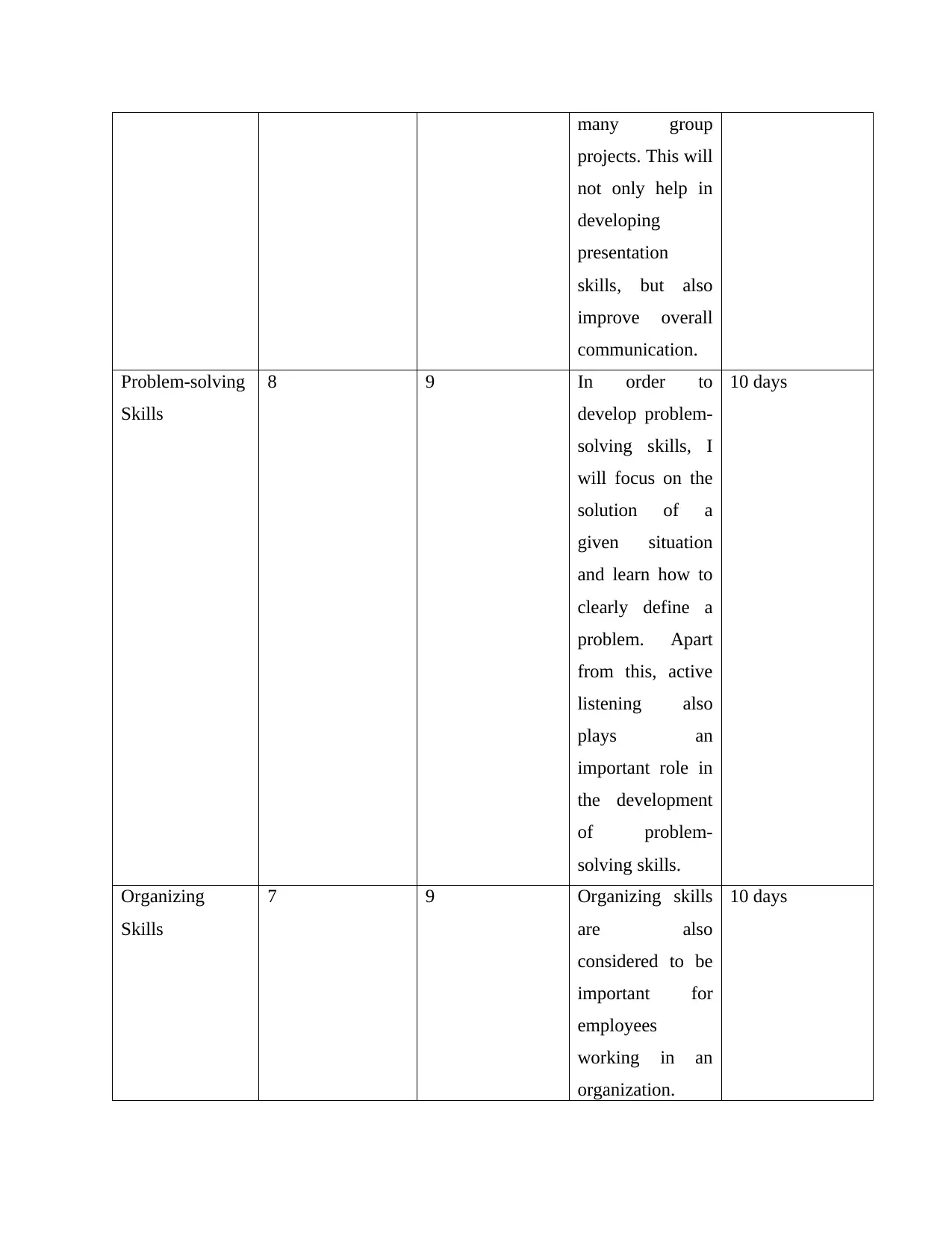
many group
projects. This will
not only help in
developing
presentation
skills, but also
improve overall
communication.
Problem-solving
Skills
8 9 In order to
develop problem-
solving skills, I
will focus on the
solution of a
given situation
and learn how to
clearly define a
problem. Apart
from this, active
listening also
plays an
important role in
the development
of problem-
solving skills.
10 days
Organizing
Skills
7 9 Organizing skills
are also
considered to be
important for
employees
working in an
organization.
10 days
projects. This will
not only help in
developing
presentation
skills, but also
improve overall
communication.
Problem-solving
Skills
8 9 In order to
develop problem-
solving skills, I
will focus on the
solution of a
given situation
and learn how to
clearly define a
problem. Apart
from this, active
listening also
plays an
important role in
the development
of problem-
solving skills.
10 days
Organizing
Skills
7 9 Organizing skills
are also
considered to be
important for
employees
working in an
organization.
10 days
⊘ This is a preview!⊘
Do you want full access?
Subscribe today to unlock all pages.

Trusted by 1+ million students worldwide
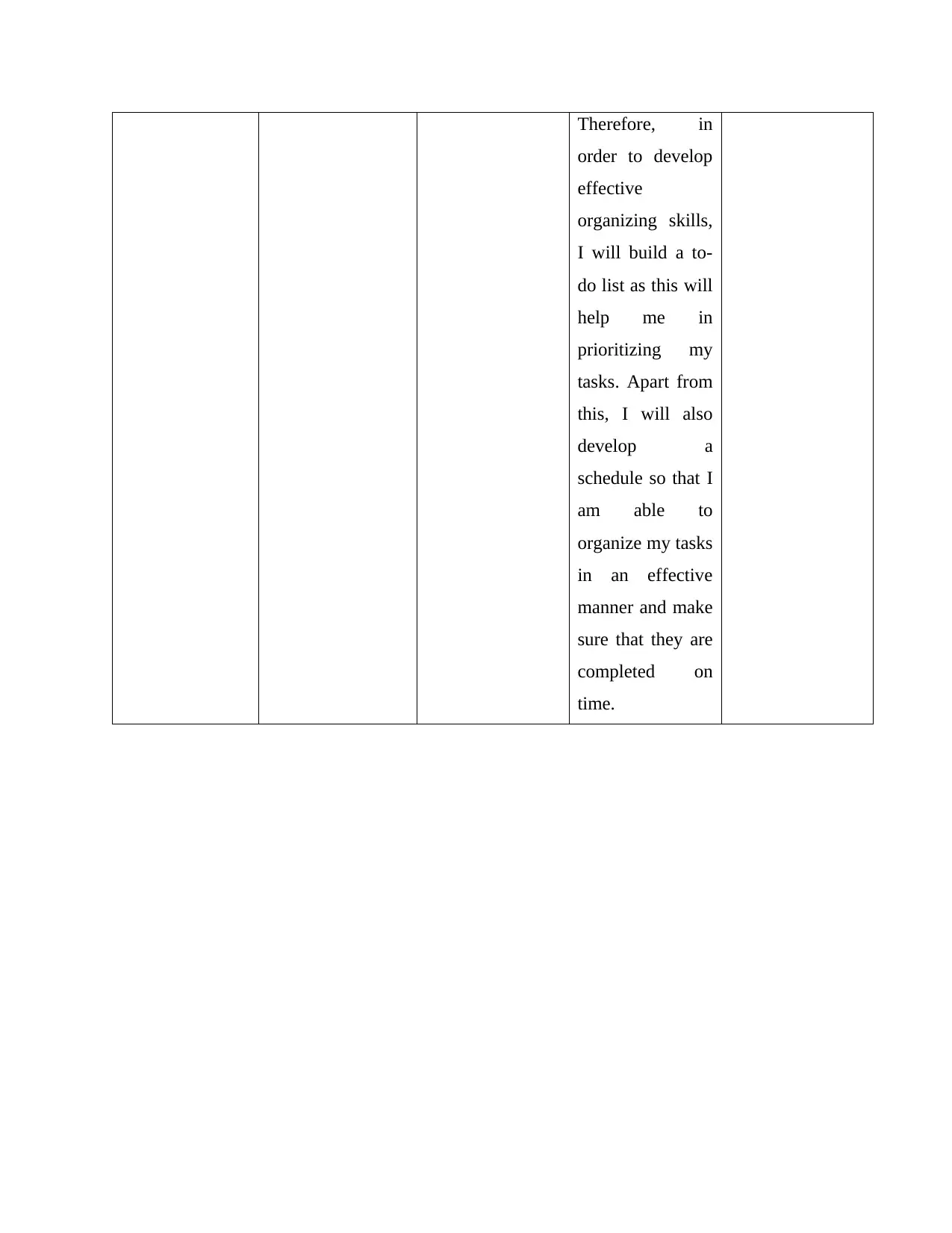
Therefore, in
order to develop
effective
organizing skills,
I will build a to-
do list as this will
help me in
prioritizing my
tasks. Apart from
this, I will also
develop a
schedule so that I
am able to
organize my tasks
in an effective
manner and make
sure that they are
completed on
time.
order to develop
effective
organizing skills,
I will build a to-
do list as this will
help me in
prioritizing my
tasks. Apart from
this, I will also
develop a
schedule so that I
am able to
organize my tasks
in an effective
manner and make
sure that they are
completed on
time.
Paraphrase This Document
Need a fresh take? Get an instant paraphrase of this document with our AI Paraphraser
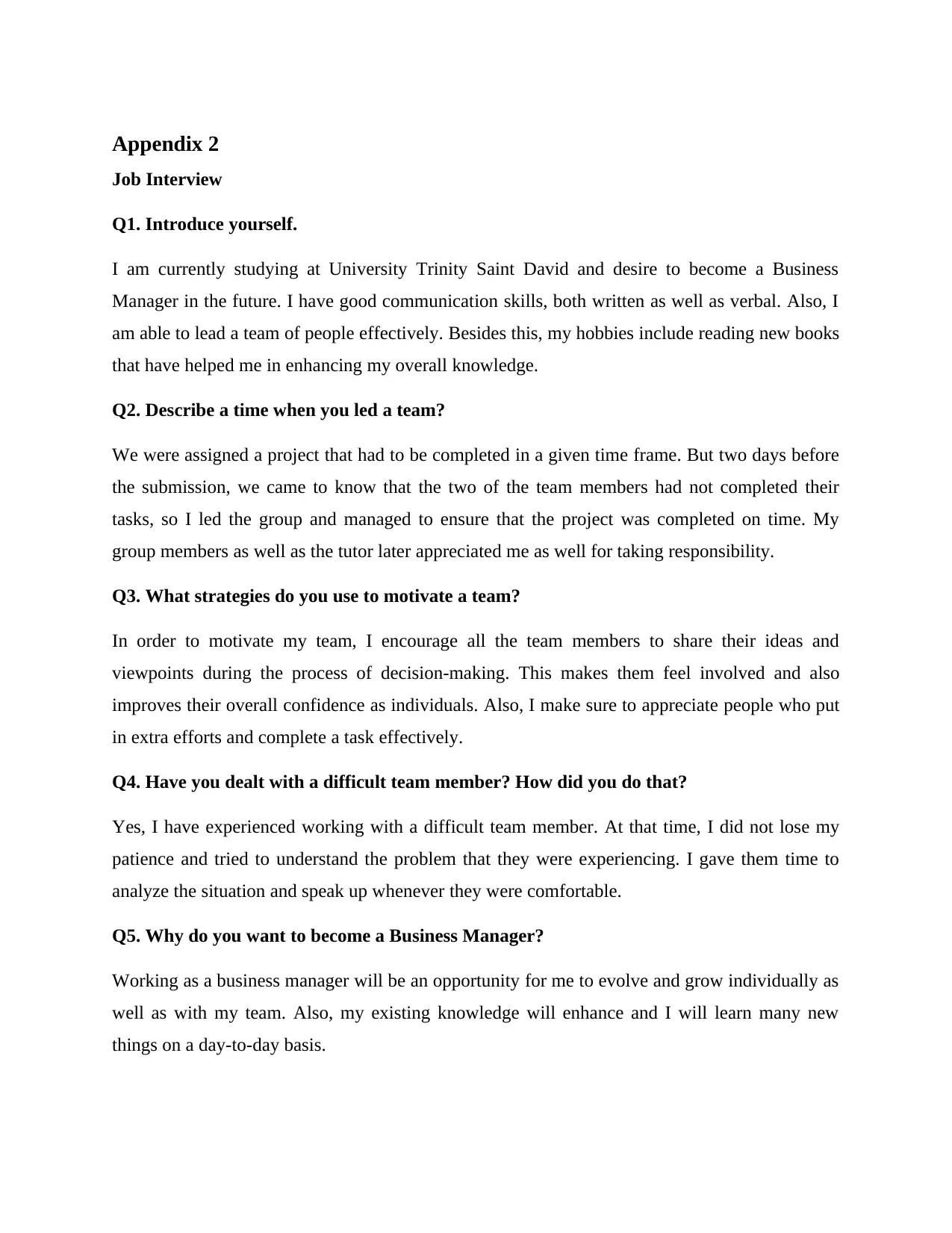
Appendix 2
Job Interview
Q1. Introduce yourself.
I am currently studying at University Trinity Saint David and desire to become a Business
Manager in the future. I have good communication skills, both written as well as verbal. Also, I
am able to lead a team of people effectively. Besides this, my hobbies include reading new books
that have helped me in enhancing my overall knowledge.
Q2. Describe a time when you led a team?
We were assigned a project that had to be completed in a given time frame. But two days before
the submission, we came to know that the two of the team members had not completed their
tasks, so I led the group and managed to ensure that the project was completed on time. My
group members as well as the tutor later appreciated me as well for taking responsibility.
Q3. What strategies do you use to motivate a team?
In order to motivate my team, I encourage all the team members to share their ideas and
viewpoints during the process of decision-making. This makes them feel involved and also
improves their overall confidence as individuals. Also, I make sure to appreciate people who put
in extra efforts and complete a task effectively.
Q4. Have you dealt with a difficult team member? How did you do that?
Yes, I have experienced working with a difficult team member. At that time, I did not lose my
patience and tried to understand the problem that they were experiencing. I gave them time to
analyze the situation and speak up whenever they were comfortable.
Q5. Why do you want to become a Business Manager?
Working as a business manager will be an opportunity for me to evolve and grow individually as
well as with my team. Also, my existing knowledge will enhance and I will learn many new
things on a day-to-day basis.
Job Interview
Q1. Introduce yourself.
I am currently studying at University Trinity Saint David and desire to become a Business
Manager in the future. I have good communication skills, both written as well as verbal. Also, I
am able to lead a team of people effectively. Besides this, my hobbies include reading new books
that have helped me in enhancing my overall knowledge.
Q2. Describe a time when you led a team?
We were assigned a project that had to be completed in a given time frame. But two days before
the submission, we came to know that the two of the team members had not completed their
tasks, so I led the group and managed to ensure that the project was completed on time. My
group members as well as the tutor later appreciated me as well for taking responsibility.
Q3. What strategies do you use to motivate a team?
In order to motivate my team, I encourage all the team members to share their ideas and
viewpoints during the process of decision-making. This makes them feel involved and also
improves their overall confidence as individuals. Also, I make sure to appreciate people who put
in extra efforts and complete a task effectively.
Q4. Have you dealt with a difficult team member? How did you do that?
Yes, I have experienced working with a difficult team member. At that time, I did not lose my
patience and tried to understand the problem that they were experiencing. I gave them time to
analyze the situation and speak up whenever they were comfortable.
Q5. Why do you want to become a Business Manager?
Working as a business manager will be an opportunity for me to evolve and grow individually as
well as with my team. Also, my existing knowledge will enhance and I will learn many new
things on a day-to-day basis.
1 out of 11
Related Documents
Your All-in-One AI-Powered Toolkit for Academic Success.
+13062052269
info@desklib.com
Available 24*7 on WhatsApp / Email
![[object Object]](/_next/static/media/star-bottom.7253800d.svg)
Unlock your academic potential
Copyright © 2020–2025 A2Z Services. All Rights Reserved. Developed and managed by ZUCOL.




